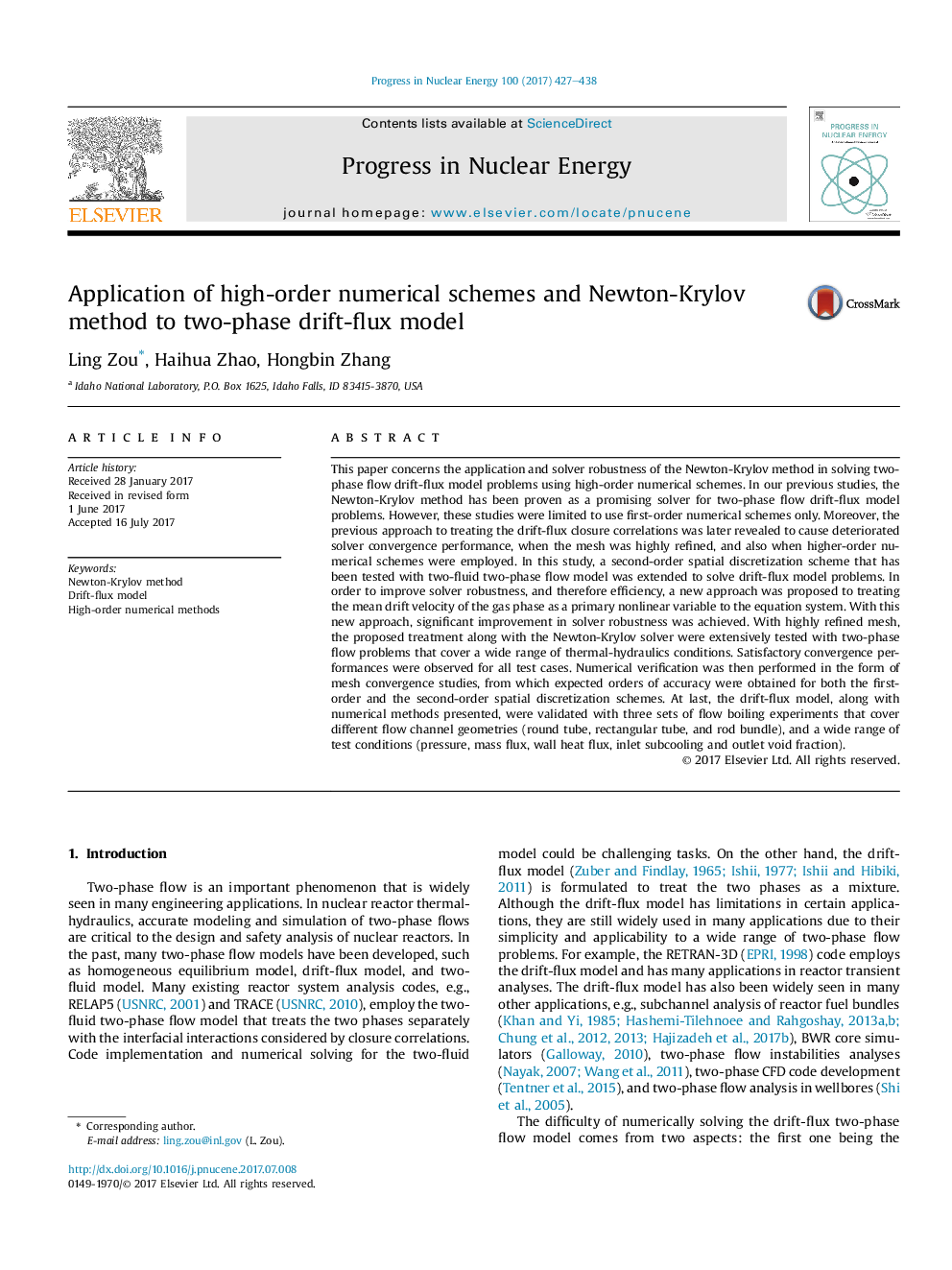| کد مقاله | کد نشریه | سال انتشار | مقاله انگلیسی | نسخه تمام متن |
|---|---|---|---|---|
| 5478200 | 1521738 | 2017 | 12 صفحه PDF | دانلود رایگان |
عنوان انگلیسی مقاله ISI
Application of high-order numerical schemes and Newton-Krylov method to two-phase drift-flux model
ترجمه فارسی عنوان
استفاده از طرح های عددی مرتبه بالا و روش نیوتن-کریولف به مدل دو فاز راندگی شار
دانلود مقاله + سفارش ترجمه
دانلود مقاله ISI انگلیسی
رایگان برای ایرانیان
کلمات کلیدی
روش نیوتن-کریولف، مدل رانش شتاب، روش های عددی مرتبه بالا،
ترجمه چکیده
این مقاله در مورد استحکام نرم افزاری و حل کننده روش نیوتن-کریولف در حل مشکلات مدل رگبار جریان شار دو فاز با استفاده از طرح های عددی مرتبه بالا است. در مطالعات قبلی ما، روش نیوتن-کریولف به عنوان یک حل کننده امیدوار کننده برای مشکلات مدل رگبار جریان شار دو فاز است. با این حال، این مطالعات محدود به استفاده از طرح های عددی مرتبه اول بود. علاوه بر این، رویکرد قبلی برای درمان همبستگی بسته شدن جریان رطوبت، بعدها مشخص شد که باعث کاهش عملکرد سازگاری حل کننده می شود، زمانی که مش بسیار تصحیح شد و همچنین زمانی که طرح های عددی مرتبه بالاتر استفاده شد. در این مطالعه، یک طرح تقسیم بندی فضایی مرتبه دوم که توسط دو مدل جریان دو فازی مورد آزمایش قرار گرفته است، برای حل مشکلات مدل رانش شفت توسعه یافت. به منظور بهبود رضایت حل کننده و در نتیجه کارایی، یک روش جدید برای درمان میانگین ریزش فاز گاز به عنوان یک متغیر غیر خطی اولیه به سیستم معادله پیشنهاد شده است. با استفاده از این رویکرد جدید، بهبود قابل توجهی در توانایی حل مسئله به دست آمد. با استفاده از توری بسیار تصفیه شده، درمان پیشنهادی همراه با حل کننده نیوتن-کریولف با مشکلات جریان دو فازی که طیف گسترده ای از شرایط حرارتی هیدرولیکی را پوشش می دهد، به طور گسترده مورد آزمایش قرار گرفت. عملکرد همگرایی رضایت بخش در تمام موارد آزمون مشاهده شد. پس از تایید عددی، به صورت مطالعات همگرایی مش انجام شد، که از آن جهت دستورالعملهای تقریبی فضایی مرتبه اول و مرتبه دوم برای دقت مورد انتظار بدست آمد. در نهایت، مدل رانش شفت همراه با روش های عددی ارائه شده با سه مجموعه آزمایش های جوش جوش که شامل هندسه های مختلف کانال جریان (لوله گرد، لوله مستطیلی و بسته بندی میله ای)، و طیف گسترده ای از شرایط آزمایش ( فشار، جرم جرمی، شار حرارت دیواره، خالی کردن ورودی و تخلخل خالی).
موضوعات مرتبط
مهندسی و علوم پایه
مهندسی انرژی
مهندسی انرژی و فناوری های برق
چکیده انگلیسی
This paper concerns the application and solver robustness of the Newton-Krylov method in solving two-phase flow drift-flux model problems using high-order numerical schemes. In our previous studies, the Newton-Krylov method has been proven as a promising solver for two-phase flow drift-flux model problems. However, these studies were limited to use first-order numerical schemes only. Moreover, the previous approach to treating the drift-flux closure correlations was later revealed to cause deteriorated solver convergence performance, when the mesh was highly refined, and also when higher-order numerical schemes were employed. In this study, a second-order spatial discretization scheme that has been tested with two-fluid two-phase flow model was extended to solve drift-flux model problems. In order to improve solver robustness, and therefore efficiency, a new approach was proposed to treating the mean drift velocity of the gas phase as a primary nonlinear variable to the equation system. With this new approach, significant improvement in solver robustness was achieved. With highly refined mesh, the proposed treatment along with the Newton-Krylov solver were extensively tested with two-phase flow problems that cover a wide range of thermal-hydraulics conditions. Satisfactory convergence performances were observed for all test cases. Numerical verification was then performed in the form of mesh convergence studies, from which expected orders of accuracy were obtained for both the first-order and the second-order spatial discretization schemes. At last, the drift-flux model, along with numerical methods presented, were validated with three sets of flow boiling experiments that cover different flow channel geometries (round tube, rectangular tube, and rod bundle), and a wide range of test conditions (pressure, mass flux, wall heat flux, inlet subcooling and outlet void fraction).
ناشر
Database: Elsevier - ScienceDirect (ساینس دایرکت)
Journal: Progress in Nuclear Energy - Volume 100, September 2017, Pages 427-438
Journal: Progress in Nuclear Energy - Volume 100, September 2017, Pages 427-438
نویسندگان
Ling Zou, Haihua Zhao, Hongbin Zhang,
